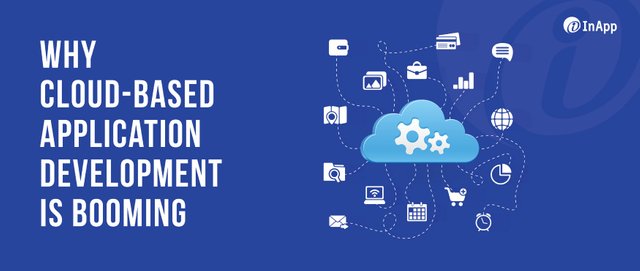Why Cloud-based Application Development Is Booming

For the past decade, businesses have embraced cloud-based application development — and there are no signs of that trend slowing down in the future. Attracted by the ease of use, scalability, and lower operational costs, cloud computing services have leveled the playing field. Capabilities once accessible only to large enterprises now are available to companies of all sizes.
The major factor in the rush to cloud-based application development is user expectations. Companies saw the exponential use of mobile apps after rapid smartphone adoption by consumers. However, the COVID-19 pandemic accelerated the need for cloud-based services in 2020 even more as off-site work became essential to doing business. When many countries instituted lockdowns, users turned to cloud-computing services to get the job done.
In 2021, the global cloud applications market had a value of $133.6 billion (US) and is expected to reach $168.6 billion (US) by 2025 at a compound annual growth rate of 4.8 percent, according to Statistica. The key drivers are expected to be increased adoption in small and medium businesses, as well as cloud services related to data management and analysis.
Let’s dig deeper into cloud-based and cloud-native applications and their impact on business.
What Is Cloud-based Application Development?
A cloud application is software deployed in a cloud environment rather than hosted on a local server or machine. Cloud application development uses private, public, and hybrid clouds to create apps. Because organizations can use cloud computing as a virtual IT structure, they can move key business functions off-site, like on-demand storage, computing services, application development platforms, and much more. It follows the same software development stages as any project, from planning to testing to deployment to maintenance.
What Are the Characteristics of a Cloud-based Application?
The characteristics of cloud-based applications and progressive web applications typically include…
- Managed infrastructure
- Easy scalability
- Geographical distribution
- Integrated security tools
- Redundancy
- Pay-for-what-you-use cost structure
What Are the Most Common Cloud Deployment Models?
Typically cloud deployment models fall into these categories…
- Software as a service (SaaS): A software licensing and delivery model in which software is centrally hosted and licensed as a subscription
- Platform as a service (PaaS): Cloud computing services in which a third-party provider delivers hardware and software tools to users over the internet
- Infrastructure as a service (IaaS): A cloud computing service model in which computing resources are hosted in a public, private, or hybrid cloud
- Serverless computing: Cloud computing execution model in which the cloud provider allocates machine resources on demand and takes care of the servers on behalf of customers.
What Are the Benefits of Cloud-based Application Development?
Companies are attracted by the numerous benefits that cloud-based application development offers, including…
- Streamlined deployment
- Managed infrastructure
- Cost savings
- Security tools
- Data recovery
- Scalability
- Resiliency
- Agility
- Continuous release
- Ease of access
What Are the Challenges of Cloud-Based Application Development?
While cloud-based application development holds many benefits, businesses should be aware of challenges, like…
- Difficult to change cloud service providers
- Time and expense involved in the migration process to cloud services
- Issues with interoperability across different cloud environments
- False or misleading claims from cloud service providers
- The complexity of system integration
- Communication issues with cloud providers
- Insufficient monitoring and security tools
Examples of Cloud-Based Applications
Because a cloud-based application is software that’s hosted in the cloud, you’ll find numerous examples on your computer and mobile device. Common applications include…
- Online storage (Dropbox, Apple iCloud, Box, One Drive, etc.)
- Social media (TikTok, Facebook, Instagram, Twitter, etc.)
- Communication (G Suite, Slack, Yammer, etc.)
- Document creation (Google Drive, Microsoft 365, Zoho Office Online Suite, etc.)
- Customer relationship management: (SalesForce, HubSpot, etc.)
- Financial (Mint, Quicken, YNAB, Banks, etc.)
- E-commerce (SquareSpace, Shopify, Big Commerce, etc.)
- Video and mobile gaming (PUBG, Minecraft, Apex Legends, Fortnite, Pokemon Go, etc.)
Step by Step Guide to Creating a Cloud-based Application
Cloud-based applications follow the same software development stages as any project.
- Concept & Planning: Identify the product requirements upfront, determine business and revenue goals, and develop a realistic timeline.
- Technical Requirements: Work with your development team to determine the best technologies, frameworks, and programming languages.
- Design: Finalize all design components such as colors, images, fonts, logos, and other artistic elements.
- Development: Develop code and review iterations to determine if requirements are met and design ideas are optimized.
- Testing & Quality Assurance: Work with an independent software testing team to ensure that everything is working well and end-users are not experiencing any issues.
- Operations & Deployment: Prepare and deploy the completed and tested code in the appropriate production environment.
- Maintenance & Updates: Make improvements, upgrade features, add functionalities, optimize performance, develop firmware updates, etc.
Ready to learn more about how cloud-based application development can help your company? Contact the cloud computing experts at InApp.